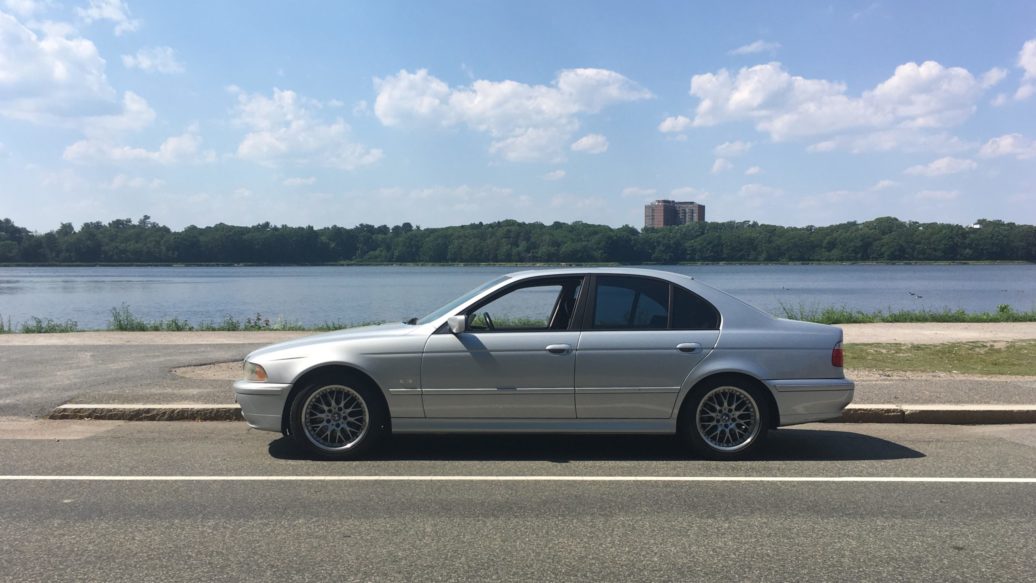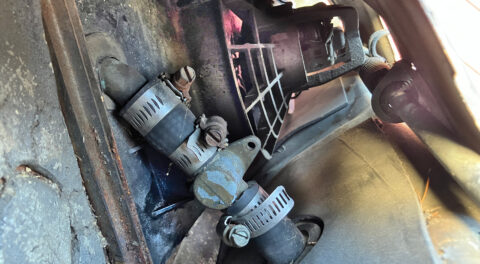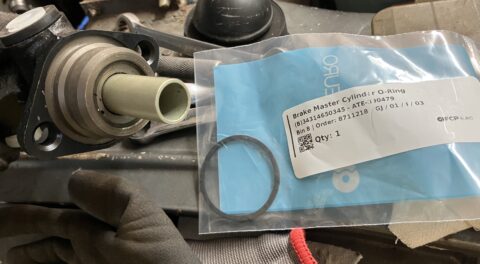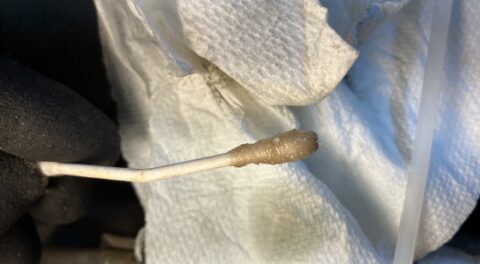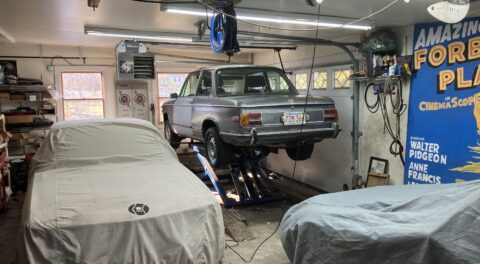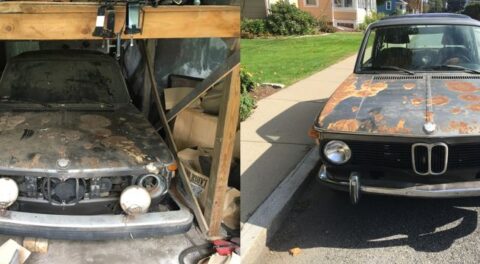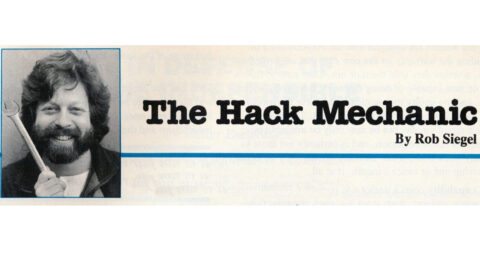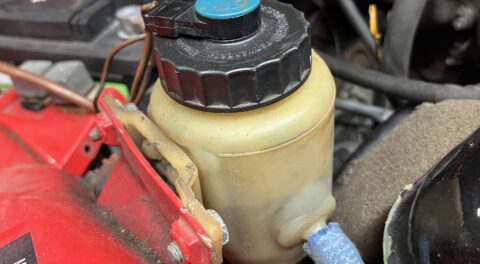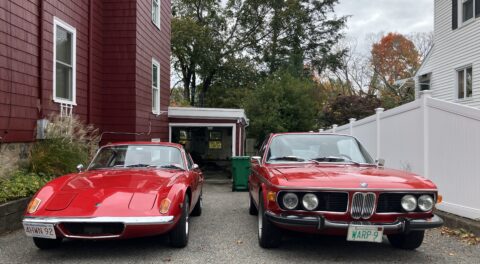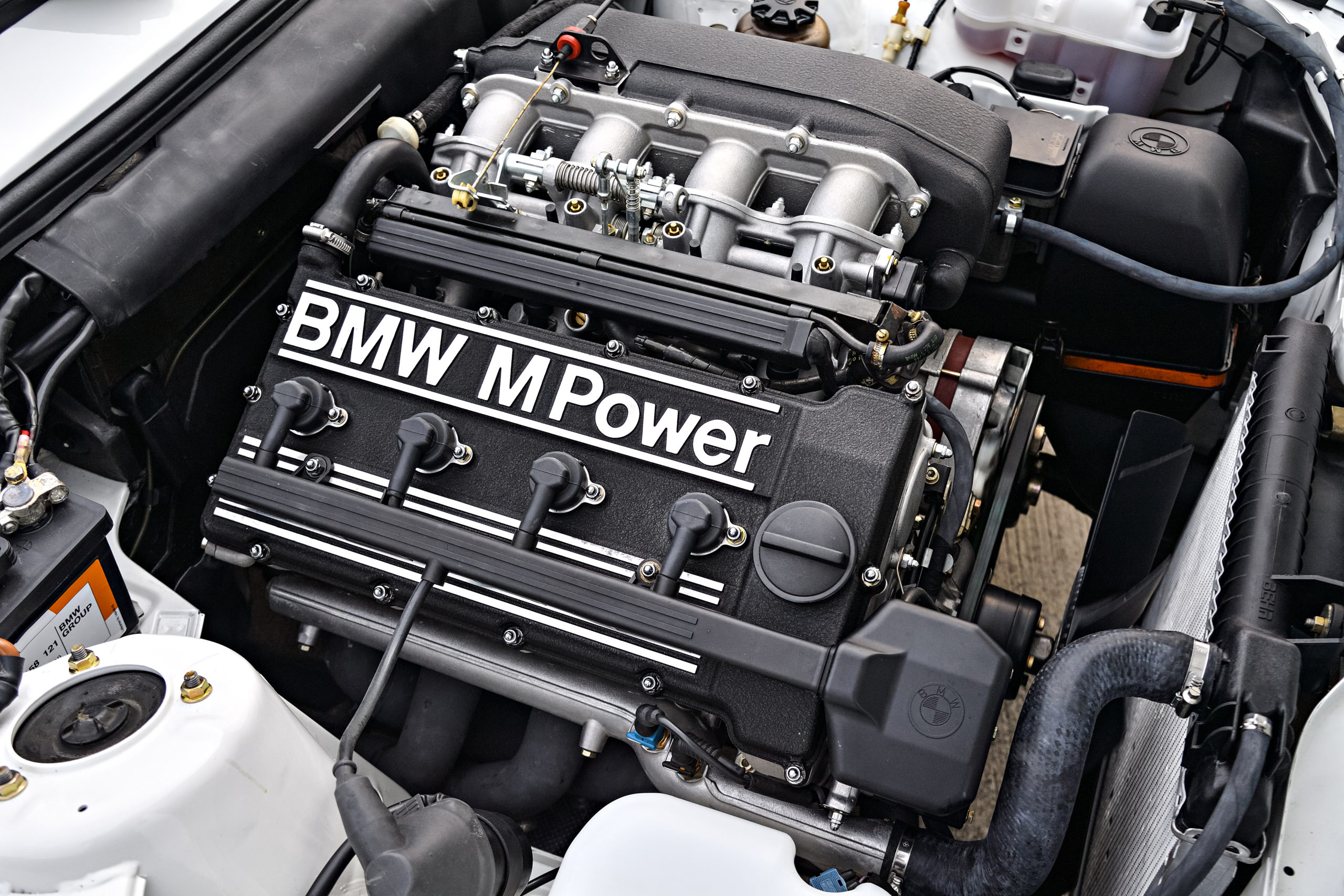So: My 2003 E39 530i stick sport, the car that I routinely describe as the best daily-driver BMW I’ve ever owned, up and died. And then it un-died: I limped it home without a tow. The next day, it spontaneously recovered; all trace of the problem vanished. I’ve done nothing yet to fix it, and I’m still driving it.
I can’t help but recall the “bring out your dead” scene in Monty Python and the Holy Grail, where the still-alive old man about to be put in the death cart says, “I’m getting better,” his son says, “No you’re not, you’ll be stone dead in a moment,” the old man says, “I think I’ll go for a walk,” his son says, “You’re not fooling anyone, you know,” and the old man says, “I feel happy! I feel happy!”
Of course, what happens next is what’s likely to happen to the car unless I actually fix what went wrong.
Here’s what happened. I was driving home from a doctor’s appointment about eight miles from home. It was hot out and very humid. The fuel tank was nearly empty. I’d just gone through an intersection when the car lost power and died. I coasted to the side of the road, tried the key, and the car restarted instantly. Hmm: strange.
I set off, and not quite a mile later, it happened again, only the car didn’t die, it just lost power and wouldn’t rev. This happened two more times. With each incident, the time between power losses became shorter. At some point, the Check Engine Light (CEL) came on.
By the fourth little death, it was 3:00 p.m. on a Friday afternoon. I was not quite halfway home, and although I was driving on local roads, I still had some high-traffic areas left to go through. I coasted into a safe area overlooking the Chestnut Hill Reservoir on the Boston-Newton line. Even though the car again restarted, the problem was clearly getting worse, so I decided that the safe thing to do was to simply call AAA and have it towed to my house. However, due to their recording my address wrong, and then insisting on scheduling a truck from the Boston side rather than the Newton side, two and a half hours later I was still there, so I decided to make a run for it and cancelled the tow.
After I set off, the problem repeated itself: The car started instantly and ran flawlessly until it lost power and refused to rev, although it didn’t die. Four more pauses of a few minutes each got me home, but I wasn’t sure I’d make it up a hill I never realized was so steep until I had to drive up it at 5 mph.
There’s an old adage that says, if a car feels like it’s running out of gas, it almost always is, at least at some level. To me, this totally felt like that, and I was thus certain that it was a fuel-delivery issue. Specifically, given my history with older fuel-injected BMWs, it felt like a clogged fuel filter. More than once I’d had the experience of driving a tii, having it stumble and die, then magically revive itself if you simply waited. In these cases, the root cause was fuel pressure pushing rust and sediment up against the screen of the fuel filter and the little mesh screens in the inlet of the fuel pump and the injection pump. If you simply waited, enough of the crud would fall off the screens to allow you to drive a short distance again before the problem recurred.
The E39 is a modern car with a plastic gas tank, and thus doesn’t self-generate filter-clogging rust the way old metal tanks do, but it’s certainly possible to get a load of sediment-contaminated fuel.
The only things that were surprising about the E39 dying were that it had taken so long to happen and that it seemed to be due to a fuel-related issue, as opposed to a cooling system-related one. This car had been sitting dead in a driveway for two years when I bought it in 2016; it clearly had been under-maintained, but after I fixed a few minor issues, it ran so well that I was afraid to disturb whatever cosmic forces were at work, and I doubled down on the under-maintenance almost as a dare to myself to see how little money I could spend and keep driving the car. Plus, I still had vivid memories of having done every bit of the preventive maintenance I was supposed to do to my 1999 E39 528i sport wagon—crankcase ventilation valve, VANOS seals, cooling system (including the miserable job of replacing those two hard plastic coolant pipes)—then had every bizarre thing in the world go wrong with the car, including it snapping a front spring and puncturing a tire.
When I bought the 530i, I was still working at Bentley Publishers in Cambridge, and had a six-mile commute along local roads. I figured that if the car cracked the expansion tank and dropped all its coolant, I’d simply pull over and get it towed home. Since it kept on running without my replacing parts that hadn’t yet broken, I ventured further and further from Newton in it, but I was always aware that I was relying on a car that had less maintenance than any other daily driver I’d ever owned. So I wasn’t mad at it in the least for this power-loss episode. Hell, the fact that it didn’t actually strand me only added to my affection for the car.
Because the CEL was lit, I plugged in my generic OBD-II code reader. It pulled a P0301 “cylinder 1 misfire” code. I can believe that during the power-loss episodes, there was a misfire, but clearly a misfire on one cylinder wasn’t the root cause of its dying.
I dug around in the garage and fired up the ancient hardened Windows XP touchscreen tablet on which I have BMW PA Soft 1.40 software, and used it to scan the car. It reported one current error—”Main relay reaction delay”—and a bunch of old minor ones. I wasn’t sure what to make of of it, but I recalled reading that fuel delivery is surprisingly sensor-less. That is, even with all the sensors and control modules on an eighteen-year-old BMW, I don’t believe that a bad fuel pump or clogged fuel filter throws a code.
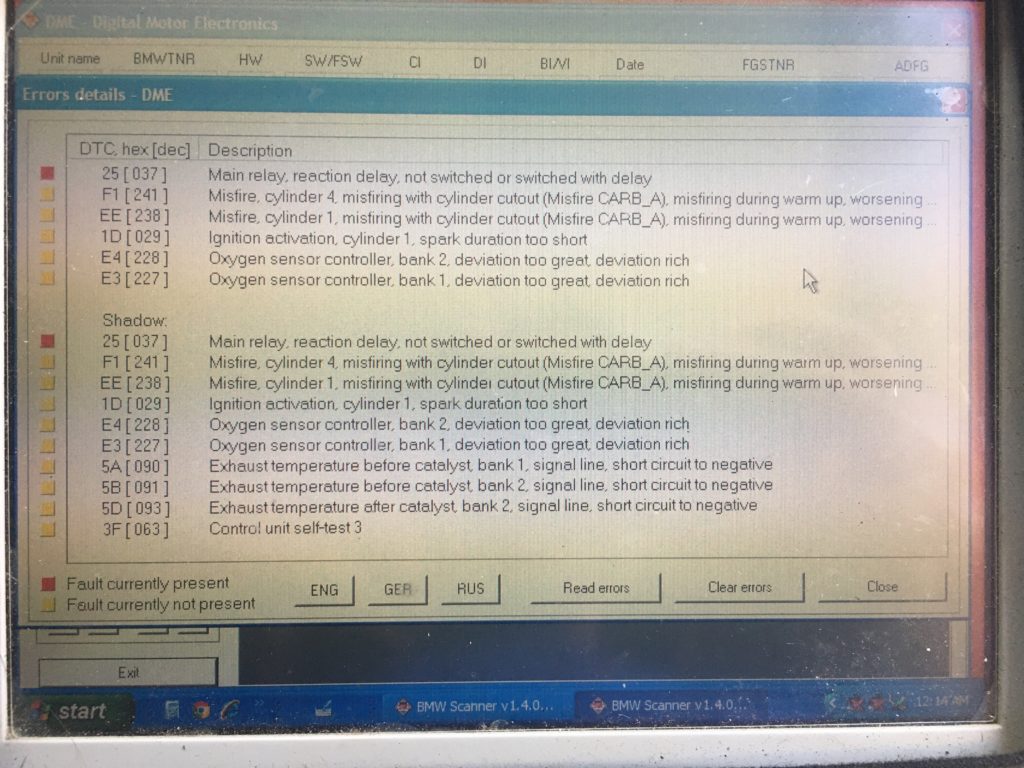
It wasn’t clear what any of this meant.
I posted the episode to the brain trust on Facebook, and got a hail of responses. There was one fellow who said that my symptoms exactly matched what happened to him when he had corrosion on the pins to the MAF sensor, and a few folks who thought the problem could be due to plugged catalytic converters, but for the most part the responses coalesced around fuel delivery. My suspicion, however, of the cause being a clogged fuel filter was generally dismissed in favor of the fuel pump. The conspiracy-theory version was that the hot weather combined with the low fuel level meant that the fuel pump wasn’t immersed in fuel to keep it cool (yes, being surrounded by gasoline cools an in-tank electric fuel pump) and might have overheated.
The next morning I cleared the codes and drove the car about five miles in circles around Newton to see if I could re-create the problem. The codes stayed clear, and I had no issues whatsoever. The fuel level, however, was so low that the warning light came on, so I was in danger of really running out of gas. I put five gallons in the tank, making it about 1/4 full. That evening, I drove the car about twenty miles on both local roads and highway, and did not spare the whip, redlining it several times. There was no hint of power loss; you’d think that the episode of the previous day hadn’t happened.
Now, much of do-it-yourself automotive repair on a modern car is a process consisting of:
- Searching online to determine the most likely cause of your problem and the replacement part most likely to fix it
- Searching online to determine whether you need to buy the OE (dealer) part, whether an OEM part (one made by the original-equipment manufacturer and available other places than the dealer) exists, or whether there’s a decent and affordable aftermarket alternative
- Ordering the part
- Installing it when it arrives, thus minimizing downtime.
If, during your search, you find a pretty good consensus that failure of a certain part fits your symptoms, and that replacing it fixes the problem, this approach generally works pretty well. It’s not causal and deterministic like old-school troubleshooting, but modern cars are complicated, we’re all busy, and the the neural network of whatever hive mind you’re connected to can be an incredible resource. So I started down the road of fuel-pump replacement.
The fuel pump lives in the gas tank, which is under the back seat. There are many good videos on removing and replacing the fuel pump, including this one from Roundel advertiser FCP Euro, and this one from a fellow with the YouTube name “HakenE30.”
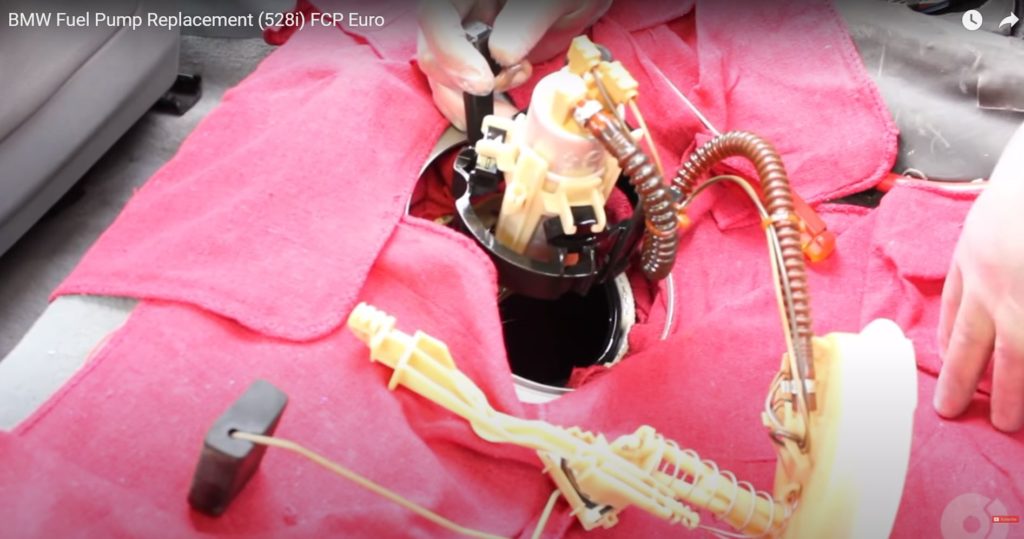
The fuel pump assembly being withdrawn from the gas tank: The electric pump itself is the white cylinder in the center. The thing at the other end of the ribbed gas line is the flange that mounts in the top of the tank with the level sensor suspended from it. [Screenshot captured from FCP Euro’s video here.]
With such a wide range of options, I did the analysis-paralysis thing and hesitated on selecting one.
Of course, the other way to approach the problem is to actually diagnose it and be certain that the fuel pump is the cause, and with the dollar amounts being up there, it made sense to me to at least take a pressure reading. Unfortunately, the fuel rail on the E39 has a tire-valve-like Schrader fitting, and neither my generic hose-clamp fuel pump or the CIS injection test kit I have left over from when I had my Porsche 911SC has a Schrader valve. I ordered this $23 fuel-pressure gauge on Amazon. When it arrived, was a bit surprised to find that I needed to grind a few millimeters off the bottom of the adapter to get it to sit on the fuel rail, but once I did, it read 50 psi, one psi short of the specification, and the reading oscillated rapidly.
I didn’t know what to make of it. It seemed that the next logical step was to get a Schrader extension hose so I could tape the gauge to the windshield, drive the car, catch it in the act, and see what the gauge read when it died.
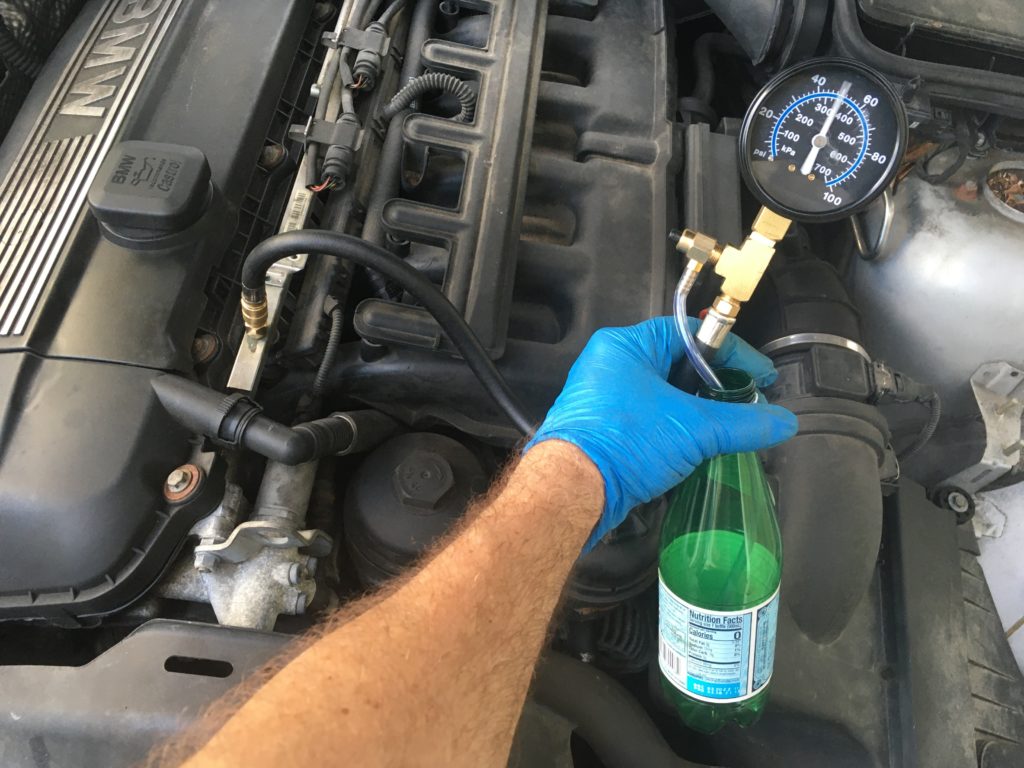
You can see the needle on the fuel pressure gauge dancing around.
Fortunately, at this point, Facebook friend Stéphane Grabina, president of the independent repair shop Excluservice of Rockville, Maryland, chimed in with the following incredibly detailed and helpful post:
- 16-14-6-752-368 fuel pump
- 16-14-6-675-370 right level sensor
- 16-14-1-183-179 (the plastic is old and may break)
- 16-14-1-182-905 x 2 rubber seal
- 16-11-6-752-839 left sucking jet pump
- 13-32-1-709-535 fuel filter included pressure regulator
- 07-12-9-952-104 x4 hose clamps (you can reuse the old ones if they are still good)”
As you can see, if you add up the dealer list price, or even the discounted list price, for all of the items in Grabina’s list, it’s a big number. This is a car that, its good condition and five-speed and sport package notwithstanding, with 200,000 miles on it, I’m kidding myself if I think I could sell it quickly for more than $1,500.
And that puts me in an interesting situation. This car is now running perfectly fine. I was already circumspect about driving it out of town, where if it failed it would be a colossal and expensive pain in the butt (I’m driving to New Jersey this weekend for a memorial service, and was already planning on taking Maire Anne’s Honda Fit even before the E39 did its odd death-and-resurrection thing). So suddenly, instead of the “web-search, guess, order, install” paradigm, it seems to make sense to switch to the “take it apart and look at it before doing anything” paradigm. But with twelve vehicles all vying for my attention and the E39 running fine, it’s slipped off the front burner.
I often say that cars are not biological systems. They do not heal themselves. If a car exhibited a problem and it wasn’t fixed, it will likely happen again, it’ll likely be worse, and pretending otherwise is denial even if the car is acting like the old man who says, “I feel happy!” I could buy a $45 pump assembly and throw it and a few tools in the trunk in case the problem recurs, but that approach feels foolhardy, even if I am just driving the car locally.
I think I’ll open up both sides of the fuel tank, inspect the transfer pump for blockage, examine the fuel pump, and if it’s original—in which case it’s got 200,000 miles on it—replace it with a Pierburg, Bosch, or Hella pump (all of which I consider reputable manufacturers).
In addition, cooling-system-wise, the lower radiator hose is feeling a bit soft. I’m not sure I have the stomach or the bank account right now for a full-on cooling-system refresh, so I ordered just that one hose (a Gates closeout on Rockauto for $15 shipped). If I’m smart, when I drain the coolant to replace it, I’ll pull the radiator so that I can see the date codes on it and the water pump and thermostat. If they’re all original, if I’m smart, I’ll spend some coin and do the long-delayed cooling-system preventative maintenance.
We’ll see if I’m smart. And then, when I drive the car, we’ll see if both it and I feel happy. And whether we suffer the same fate as the old man who’s about to be put in the cart.—Rob Siegel
Rob’s new book, The Best of The Hack Mechanic, is available here on Amazon, as are his seven other books. Signed copies can be ordered directly from Rob here.

